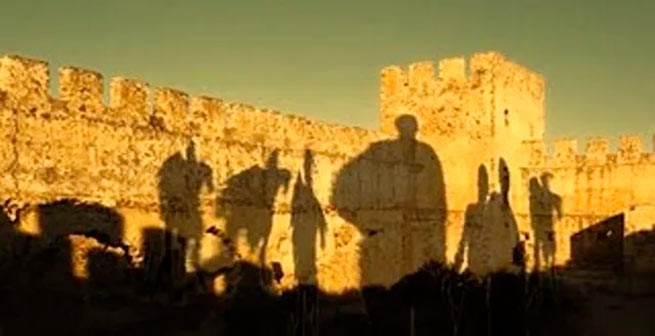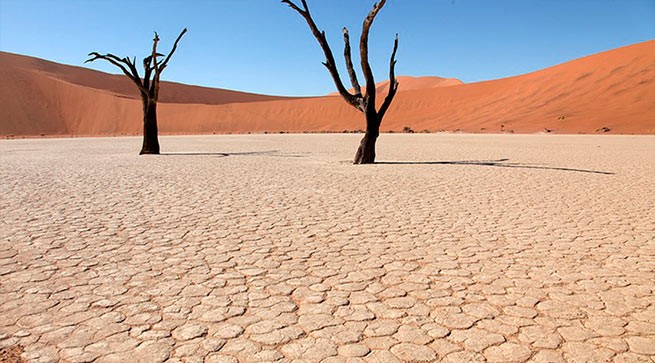The fires that hit Greece once again gave rise to a cycle of discussions about “tomorrow”. Accelerating climate change, the desertification scenario, and how close we are to zero and what that means are some of the questions experts are asked to answer.
While an accurate prediction of “tomorrow” seems impossible at the moment, future fire prevention and individual responsibility appear to be the main pillars of the most optimistic scenarios. On the contrary, dystopian scenarios speak of irreversible ecological collapse.
Kostas Sinolakis: “We are close to a ‘tipping point’ from which we will not be able to recover.”

Kostas Sinolakis is Professor of Natural Disasters, Scientist and President of the National Committee on Climate Change. Photo In time.
The most obvious link that most people make about fires and climate change is, by far, high carbon dioxide emissions. However, in reality, their main consequence is the changes they cause in the ecosystem, many of which are irreversible. This is our main problem.
Many of the islands in the Aegean that we consider dry once had forests.
To make it clearer, let’s take, for example, many of the islands of the Aegean Sea, which in our time we consider arid. In ancient times, there were forests on these same islands. The reason why these forests have not survived to this day is that our ancestors used them either as fuel or as a building material for houses, ships and boats. Therefore, gradually these forests were cut down and in the future they could not grow again, creating the dry landscape that we see today in the Aegean Islands. This is what we also fear for large areas of forest affected by fires: deforestation of the landscape and loss of land.
When we talk about the loss of soil, we mean the loss of the soil that supports the entire ecosystem: plants, trees, shrubs… Gradually, this leads to desertification, and different ecosystems appear, far from those that we would like to have near our suburban area. At present, we cannot answer the question of how close we are to “complete” ecological collapse. But there is no doubt that we are close to “zero”, or, to be more precise, to a “tipping point” from which we will not be able to recover. We may even have already reached that inflection point, I cannot know. All I know for sure is that we need to change the way we live and also rethink our personal choices, beyond the choice of governments in the field of energy production. More specifically, overconsumption of goods and food waste leave a huge carbon footprint and strongly influence climate change.”
Efthymis Lekkas: “We are not talking about a hypothetical scenario that vaguely concerns future generations. We are talking about the present”
Efthimis Lekkas – Professor of Dynamic Tectonics, Applied Geology and Disaster Management at the University of Athens, President of OASP.
When we talk about desertification, we mean desertification. When we talk about desertification, we mean not just a picture of a desert, but a situation where the soil and its subsoil have lost all conductive components and elements. In other words, the necessary chemical processes to sustain flora and fauna, both above and below the surface, do not occur.
It’s not a viable situation where you can’t even stand at a bus stop without air conditioning.
Take Dubai, for example, where the desert cannot support normal flora and fauna. Therefore, an economic opportunity has appeared to create and develop an artificial civilization, which actually relies on “wooden props”. So if someone cuts the power, it’s all over, because it’s not a viable situation where you can’t stand without air conditioning even at a bus stop.
We, as a country, are on the verge of such a situation. Of course, this is a state, a process that develops gradually, and not from one moment to another. In Attica, however, we already have a certain degree of desertification. Of course, as long as our forests continue to disappear at this rate, given the climate crisis, the picture will only get worse. If, for example, Parnita burns down completely, I don’t know what will be left. Undoubtedly, we are at zero. It is important to understand that we are not talking about a hypothetical scenario that is vaguely about future generations. We are talking about the present moment. As for the extent to which we must change this situation, the state, of course, bears a certain share of responsibility, but it is very important that each person takes personal responsibility, especially with regard to elementary fire safety rules. Only if changes come from the bottom up can we conquer the top.
Alexandros Dimitrakopoulos: “There is no reason to panic, but there is no reason to complacency either”
Alexandros P. Dimitrakopoulos is Professor and Chair of the Department of Forestry and the Natural Environment at the Aristotle University of Thessaloniki. Photo: A.P. Dimitrakopoulos
Desertification is defined as the complete degradation of a natural resource, soil, which in the countries of the Mediterranean Basin is caused by repeated cycles of fires and overgrazing. Frequent fires destroy the natural vegetation cover, thereby exposing the soil surface to heavy autumn rains, which leads to soil erosion, reduced water retention and the destruction of its productive capacity. Fires recurring at short intervals (less than ten years) cause extensive soil erosion and, ultimately, desertification of the territory. The phenomenon of desertification in Mediterranean European countries as a consequence of climate change (i.e. drier and warmer atmosphere) has been of concern to the European Union since 2000, making it the main target of the HORIZON research program during the decade 2000-2010. The endless cycle consists of four main points: climate change – increase in the number of forest fires – soil erosion – desertification.
Heat wave is a “silent killer” that terrorizes the planet
In Greece, especially in the Attica Basin, Mediterranean vegetation (pine forests and broad-leaved shrubs) has developed evolutionary biological adaptation mechanisms that allow for natural regeneration of scorched ecosystems after a fire if the field is left untouched by human intervention (e.g., grazing). This year’s fires in many cases spread to relatively recently burnt areas (Derbenochoria, etc.).
The ecosystem will not “collapse” in the next thirty years
There is no reason to panic, but there is also no reason to be complacent: the ecosystem will not “collapse” in the next thirty years. However, as weather conditions will become more and more conducive to the occurrence and spread of fires in the future, we need to develop effective plans in time to prevent and extinguish forest fires, inform the inhabitants of forest areas, and above all, change the institutional framework for building in forest areas and the responsibilities of local governments in managing forest fires. In other words, we need to change the rules by which we can build, manage, and live in forests in order to protect them from wildfires.
Source cathimerini







More Stories
Shock: Drag queen will carry the Olympic flame in Paris
What influenced Greece’s decision to help Kyiv with weapons?
The Minister of Health called the protesters "insignificant people, kafirs"